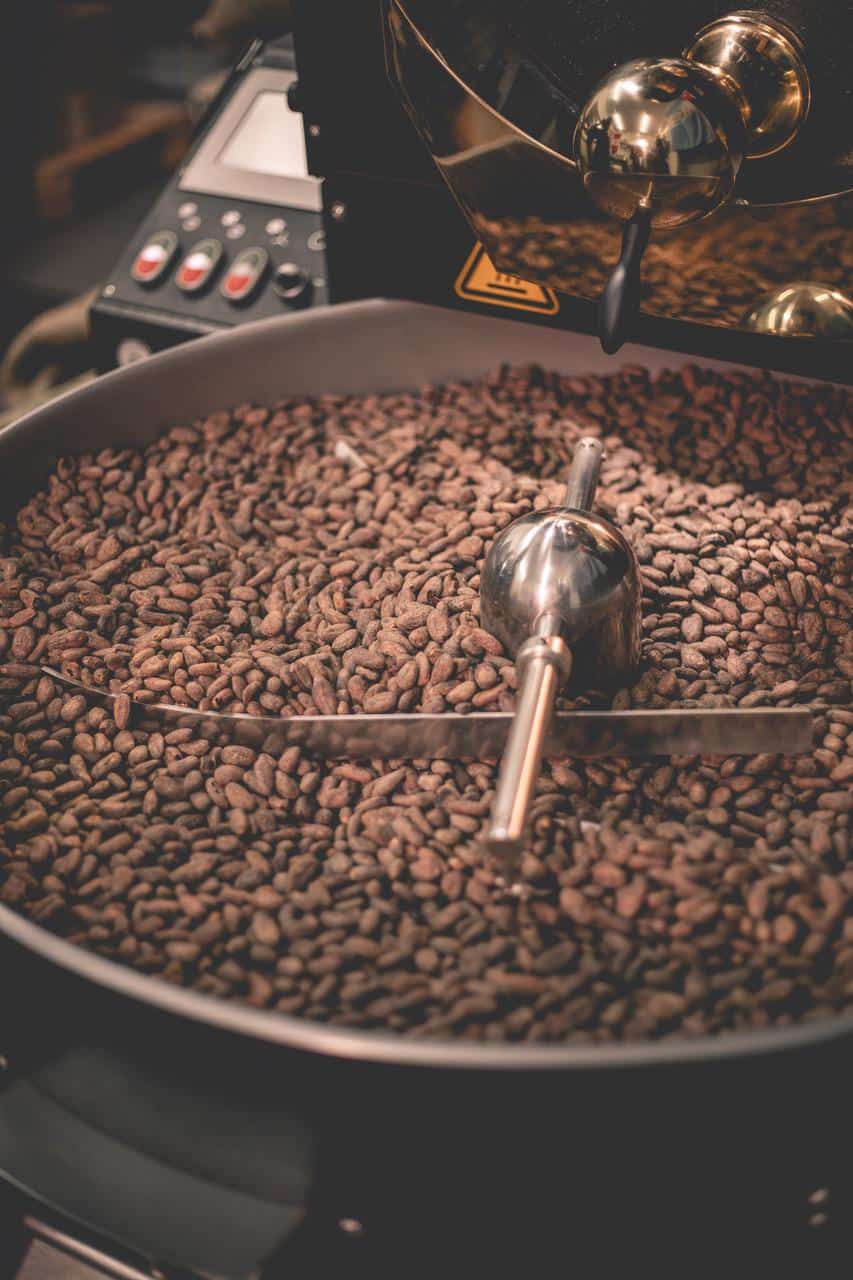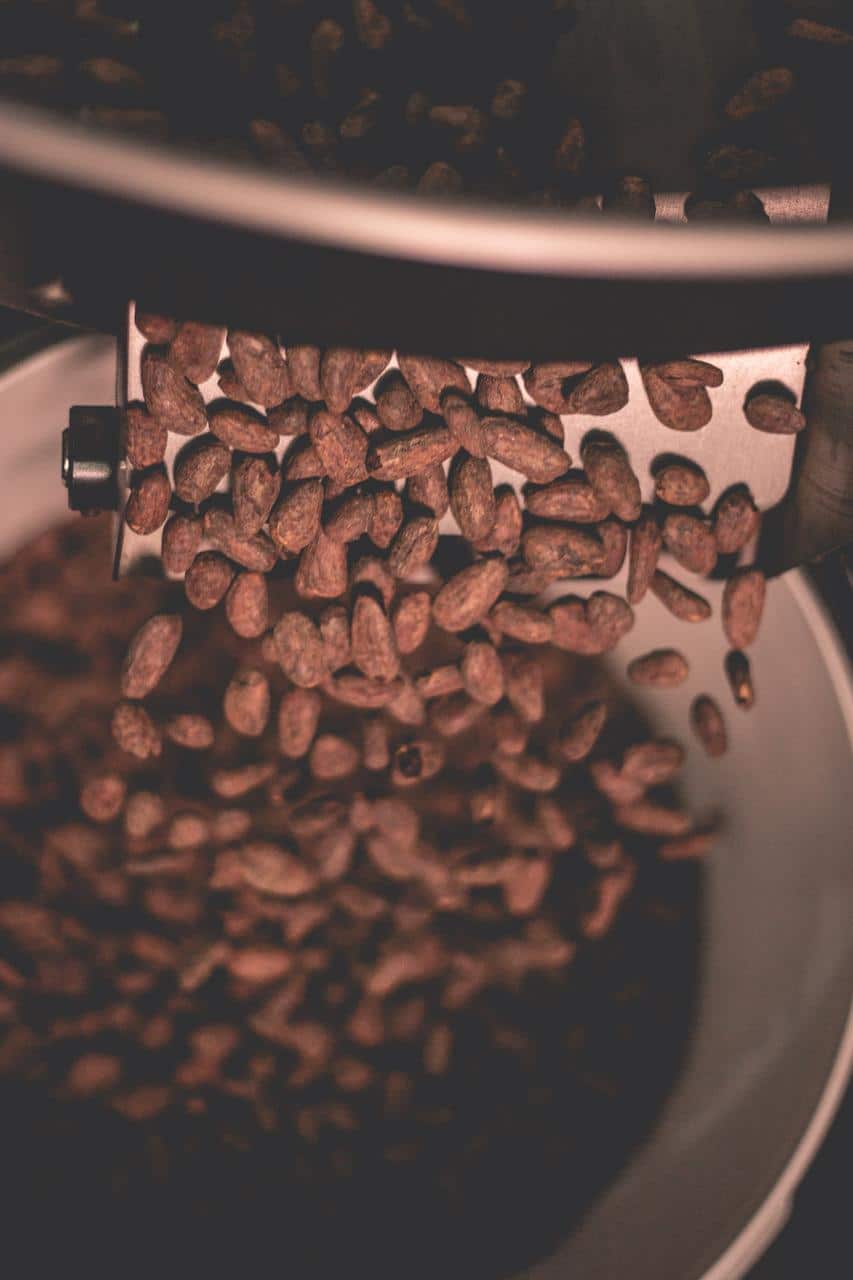UNRAVELING ROASTING-INDUCED CACAO FLAVOURS

Cacao beans are an extremely complex raw material. Its intrinsic nature has such a unique chemical makeup that it can open up endless possibilities for exquisite flavours in chocolate.
We’ve talked a lot about fermentation, drying, and genetics, but today we take a look behind the science of roasting cacao, and how to unlock flavours while roasting!
WHY DO WE ROAST CACAO BEANS ?
During roasting, the typical chocolate flavours and specific texture of the beans are developed, and unwanted volatiles are eliminated. Roasting allows beneficial aroma molecules to form in the cacao bean. These beneficial aromas include the classic cacao flavour that we associate with chocolate.
Depending on the quality of the cacao bean, endless possibilities of other pleasant aromas (such as berry, buttery, nutty) can be unlocked. The flavour diversity of chocolate has even been proven to be greater than that of wine…
WHAT HAPPENS DURING ROASTING ?
Both physical and chemical processes take place during roasting, creating desirable -or less desirable- flavours.
- Reducing the moisture :
Cacao beans have a moisture content of around 7 to 8%. In general, the moisture content is reduced by about 4 to 5%. It is important from a food safety point of view to expel as much moisture from the bean as possible. The lower the water content, the harder it is for bacteria, mould and fungi to grow and pose a health threat.
- Kill-step of bacteria or fungi:
While farmers might have very good practices on hygiene, there is always a risk for harmful bacteria, fungi and mould. Possibly there might be as well biological hazards to contaminate the beans such as bugs or cacao moths. With the exposure to heat, any harmful bacteria, fungi or mould is being killed. If some heat-resistant bacteria still survived, there is still a possibility to be killed with the heat of refining.
- Escaping of volatile acids:
Roasting at sufficiently high enough temperatures will lead to the evaporation of volatile acids (sour aromas), which will reduce the acidity.
- Unlocking the flavours::
Flavour precursors developed during fermentation and drying can be activated thanks to chemical reactions in the beans induced by heat. Strecker degradation and non-enzymatic browning processes (Maillard reactions) between sugars and proteins can take place. Amino acids, peptides and sugars interact and form flavours (aroma molecules), such as alcohols, pyrazines, aldehydes, ketones, furans, acids, amines, pyrols, esters, etc… It is not due to the combustion of the product, but due to the temperature change that pigmentation and browning take place. Both time and temperature affect how the flavour precursors are used during roasting.
>> With these physical & chemical reactions, the organoleptic characteristics of cacao beans are being expressed!

THE ROASTING PROCESS
We often get the question ‘At what temperature should we roast the beans?’ Actually, the answer is not that simple, since many parameters play a role. Eg, depending on the roasting machine, the ‘concept of temperature’ can cover a different meaning. Are we talking about ‘air temperature’, ‘load temperature,’ or ‘bean temperature’? It also depends on bean quality, bean size, moisture content and the recipe and creativity of the maker.
Roasting of Specialty Cacao beans is normally conducted at temperatures between 100°C to 130°C to express a maximum of flavours. Temperatures above 140°C or roasting too long will result in over-roasted beans with burnt, bitter, and more coffee-like flavours.
The roasting temperature and the roasting time depend on the size, the quality, and humidity of the cacao beans, and the goals of the chocolate maker on which flavours (s)he wants to express.
Roasting is a process. It is pretty well established that cacao-roasting has 4 distinct phases in the roast.
- Drying Phase
When loading your cacao beans in a pre-heated oven, drum or roaster, the temperature will first go down until you reach the point where the temperature of the beans meet the temperature of the oven/roaster, and at that turning point the beans start to heat. In this phase humidity and acidity escapes. - Development Phase
When you reach a certain trigger temperature, Strecker degradation and non-enzymatic Maillard reactions can take place. Flavours are developed. - Finishing Phase
In the finishing phase, the development is coming to an end. Make sure not destroying the desired flavours. - Cool Down Phase
The chemical reactions associated with roasting will continue for as long as the beans are hot. This means that the rate of cooling is almost as important as the roast itself. If some roasts take an hour to cool, and others 10 minutes, you may find yourself ending up with very different results.


HOW TO STEER FLAVOUR DURING ROASTING ?
About 600 aroma compounds have already been described in cacao (Aprotosoaie et al., 2016), which can be unlocked by roasting. The possibilities are countless, endless.
Let’s get behind the ‘steering wheel’ and explore some pathways for steering in a certain direction…
When the roasting starts, the amino acid, peptide or protein interactions get kickstarted in combination with sugars. Reducing sugars like fructose and glucose are critically involved in the development of a typical chocolate flavour through Maillard reaction with amino acids. While Maillard can start to take place at lower temperatures, it is optimal at + 140°C. Ziegleder (1991) reported that 25% of free amino acids, and 70% of the reducing sugars (glucose and fructose) are used up during Maillard reaction.

ARE YOU READY FOR SOME CHOCOLATE ALCHEMY ?
Are you interested in a brief walk-through some of the chemical classes that contribute to cacao flavour? Let’s get ready for some chemistry lingo.
- Alcohols
Alcohols are formed during fermentation as a result of microbiological activity, or may be the result of heat breakdown of amino acids. During drying and roasting, the concentration decreases due to volatilization. A high alcohol concentration is desirable to obtain floral and candy-like notes. Typically, linalool is associated with floral and tea-like aromas.
- Aldehydes & Ketons
Aldehydes are an other important family of aroma compounds, and formed via the Stracker breakdown of amino acids. What’s interesting about this group is that low concentration of aldehydes may arise even during fermentation!
Again, high temperatures and long roasting times may decrease the content of aldehydes. Aldehydes and ketones can combine to produce malty, chocolate, floral and sweet notes. Aldehydes can also contribute to the formation of some pyrazines.
- Pyrazines
Pyrazines are probably the most important class of volatile aromas to the overall chocolaty flavour. It is during the Maillard and Strecker reactions that most pyrazines are formed, although some are formed during drying. Pyrazines are volatile heterocyclic nitrogen containing compounds. They form the typical cacao and cacao butter flavours we are familiar with, but can display also nutty, earthy and spicy aromas. The genetics of the cacao beans also determines the total concentration of pyrazines. Eg, Nacional cacao has relatively low concentration of Pyrazines.
Very high temperature and prolonged roasting times can negatively impact the concentration of pyrazines. That said, some studies have shown that pyrazines may increase with extended roasting time (Khairy et al., 2018).
- Esters
Esters are the second most important class of volatiles. They can be present in roasted and unroasted cacao, and can arise from amino acids but also from yeast metabolism. They confer a fruity flavour in unroasted cacao beans, and fruity, floral honey and even spicy or balsamic notes in roasted cacao.
- Acids
During fermentation the concentration of organic acids increases as a result of sugar metabolisms, and displays sour and vinegary like aromas. By drying cacao, these volatile acids are reduced, and an additional 70% of acids escape during roasting.
- Phenols
Phenol and 2-methoxyphenol are compounds with aroma-damaging properties. They arise during drying or storage due to contamination from charcoal smoke or burning wood. Roasting between 110°-130°C increases the phenolic content. High quality cocoa should be free of this.
Next to these main groups, there are many other components such as proteins, peptides, polyphenols, vitamins, lactones, pyrones, etc. that can participate in the roasting process and influence the flavour of the cacao. Typical theobromine, caffeine and diketopiperizines* contribute to bitter notes.

LET’S GET THE ROAST RIGHT : DEFINING THE OPTIMAL ROASTING PROCESS
There is no right or wrong with roasting. We like to say that half the work is in our hands, and half the work is in the hands of the chocolate makers. Optimal roasting parameters depend on the raw material’s potential -which in turn is linked to genetics and post-harvest, and the chocolate maker’s ability to unlock or express certain flavours. In artisanal chocolate, cacao beans are usually roasted between 100°C and 130°, for 15 to 45 minutes.
This should not be a limitation to play with your creativity, and turn it upside down to express different flavours. Each chocolate maker has his/her own signature on how to roast beans, and determines the temperature and length of each batch of beans. Creativity has no limits, as long as it tastes good! Just do it and try, it is the only way to learn. The Proof is in the Pudding/Roast !
SOME TIPS & TRICKS TO DEFINE YOUR ROASTING PROFILES
We don’t have all the answers, but sure we can give you some hints of answers.
>> Check the size and uniformity of the beans: more uniform beans will have a more uniform flavour development as heat reaches the center of the beans around the same time. A batch with many small beans will reach high temperatures faster, so a lower roast is recommended.
>> Check the moisture content of the bean at the beginning and at the end of the process, so you can standardize the process between different batches of the same quality.
>> Assess the cacao quality and the potential of the raw material. Fine/delicate flavours tend to go for a very low roast profile. If you feel interesting nutty tones and too high of astringency, you might want to activate Maillard to express the nutty tones and reduce the astringency. This will be a compromise for sacrificing possible volatiles with floral or fruity tones.
>> Experiment and play with different roasting levels to discover the potential of what you can unlock in the beans. This way you can define the flavour notes that work best for the recipe you want to develop. A low roast is recommended for the expression of delicate floral and fruity flavours. For dark sugar, sweet, nutty flavours, a medium roast is recommended. If you want to remove off-flavours, go for a high roast. Once you start to taste burnt notes, very chocolate tones and/or a dull profile, you may have roasted the cacao beans too long.
Try again with some low roast to express the delicacy of the beans, or change your bean supply 😉

INSPIRATION, CREDITS & REFERENCES
Credits pictures: Hasnaâ Chocolats Grands Crus & Silva Cacao
ice.edu/blog/ruling-roast-chocolate-craftsmanship
chocolatephayanak.com/unkategorisiert/how-to-roast-cocoa-beans/
beantobarworld.com/chocolate-research/chocolate-aroma-factors-importance-and-analysis
*diketopiperizines – this word could boost your scrabble score
